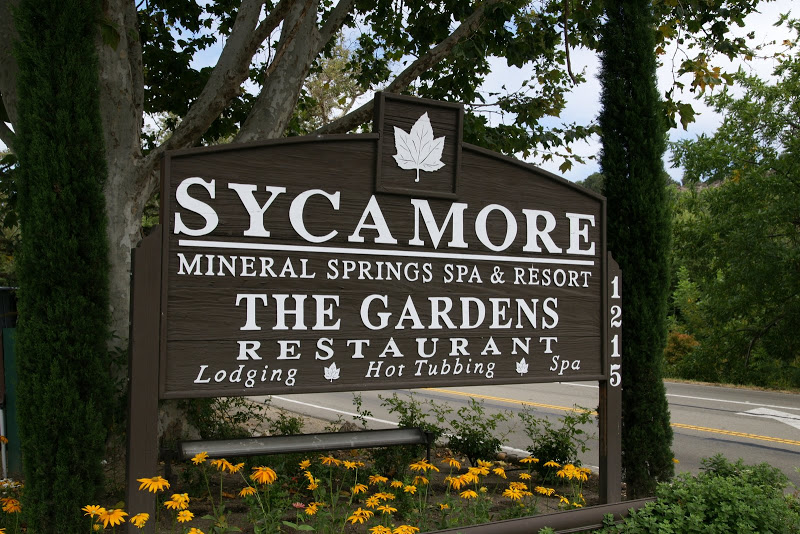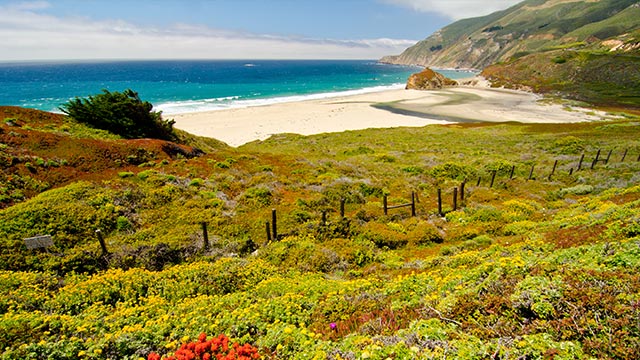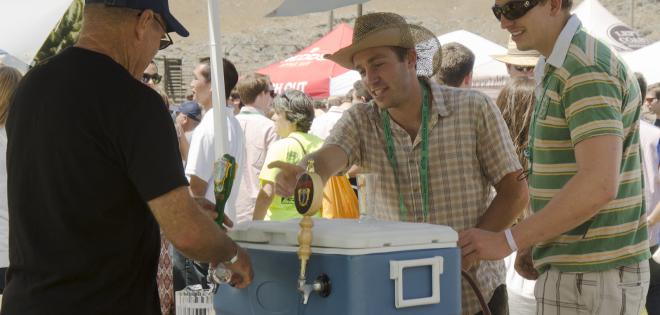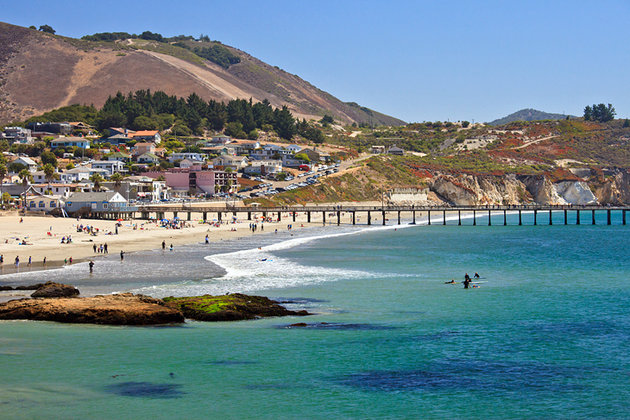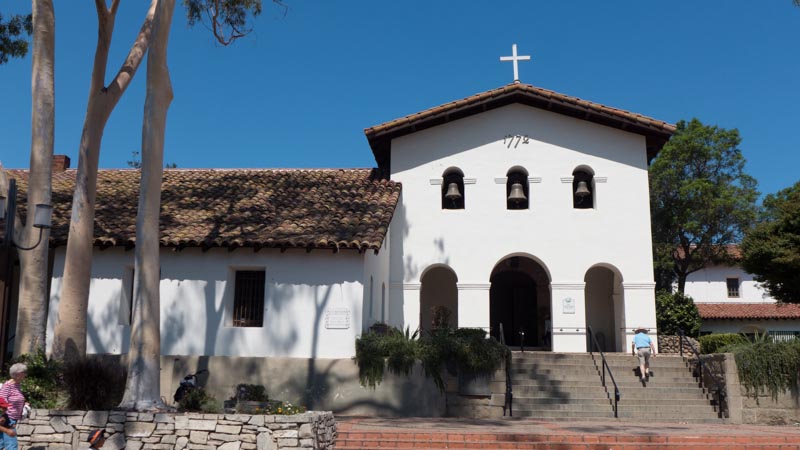San Luis Obispo is one of the hidden gems of the California central coast. Located roughly about half way between Los Angeles and San Francisco, San Luis Obispo or SLO sits eleven miles inland from the Pacific and features a cool Mediterranean-like climate. As the home to California Polytechnic State University or Cal-Poly, San Luis Obispo is the local cultural mecca for music, arts and dining.
 “Consistently acclaimed as one of the top ten places to live in the United States, visitors will find plenty to do in San Luis Obispo. SLO boasts many excellent golf courses, plenty of vineyards, miles of surfable coast line, low traffic roads or aggressive single track trails for biking, dozens of hiking trails, great ocean and lake fishing, several hot springs and spa choices, incredible dining and lodging options, and thousands of nooks where you can just enjoy nature and leave the daily grind behind.” [1]
“Consistently acclaimed as one of the top ten places to live in the United States, visitors will find plenty to do in San Luis Obispo. SLO boasts many excellent golf courses, plenty of vineyards, miles of surfable coast line, low traffic roads or aggressive single track trails for biking, dozens of hiking trails, great ocean and lake fishing, several hot springs and spa choices, incredible dining and lodging options, and thousands of nooks where you can just enjoy nature and leave the daily grind behind.” [1]
Like almost all the major central coast cities, SLO was originally settled by the Chumash over eleven thousand years ago. [2] The modern city was founded in 1772 by Spanish Franciscan Junípero Serra, San Luis Obispo is one of California’s oldest communities. Serra’s original mission was named for the 13th Century saint and bishop Louis of Toulouse and locally referred to as San Luis.
THE MISSION SAN LUIS OBISPO DE TOLOSA

“On September 1, 1772 a cross was erected near San Luis Obispo Creek and Father Junípero Serra celebrated the first mass, marking the site as the destination for the mission San Luis Obispo. The Chumash helped construct wooden  palisades, which would serve as temporary buildings for the Mission. However, due to several Indian tribes which were determined to get rid of European settlers, they set these buildings ablaze. Because of this, the Spanish were forced to rebuild the buildings using adobe and tile structures.”
palisades, which would serve as temporary buildings for the Mission. However, due to several Indian tribes which were determined to get rid of European settlers, they set these buildings ablaze. Because of this, the Spanish were forced to rebuild the buildings using adobe and tile structures.”
“The mission San Luis Obispo was part of a string of missions in California which were created in order to control the coast so that the ships from Spain would remain safe as well as bring the native people to the Catholic faith. At the missions, the Spaniards introduced native people to the European lifestyle and taught them their religious beliefs as well as Spanish and Latin for services, how to read music, sing as well as how to be skilled weavers, seamstresses, carpenters, tile makers, farmers and cattle herders. The original mission church is still standing and operation. You can visit and see its unusual L-shaped design that is found nowhere else among the California missions.”
THE FESTIVAL OF BEERS
 Every year, San Luis Obispo hosts the California Festival of Beers Its one of the largest and is the oldest regional beer festivals in California. Held on Memorial day weekend the festival is celebrating its 31st anniversary this year. The Festival is a benefit event managed and
Every year, San Luis Obispo hosts the California Festival of Beers Its one of the largest and is the oldest regional beer festivals in California. Held on Memorial day weekend the festival is celebrating its 31st anniversary this year. The Festival is a benefit event managed and
 maintained by Hospice of San Luis Obispo County (Hospice SLO County), a non-profit grief counseling organization, and receives 100% of the proceeds.
maintained by Hospice of San Luis Obispo County (Hospice SLO County), a non-profit grief counseling organization, and receives 100% of the proceeds.
The California Festival of Beers brings together live music, local foods, art viewing and a wide selection of beers than ever before. At “Arts and Drafts,” attendees will learn from the beer pairing master Dr. Bill Sysak, beverage coordinator of Stone Brewing World Bistro & Gardens and a recognized figure of the craft beer community.
 “This event has had amazing growth and support over the years and it is a major source of income for Hospice SLO that allows us to continue to provide free services to the community,” said Executive Director Kris Kington-Barker. “We could not manage this without the backing of the brewers, sponsors, vendors and hundreds of volunteers who make this happen every year.”
“This event has had amazing growth and support over the years and it is a major source of income for Hospice SLO that allows us to continue to provide free services to the community,” said Executive Director Kris Kington-Barker. “We could not manage this without the backing of the brewers, sponsors, vendors and hundreds of volunteers who make this happen every year.”
Over 4,000 attendees each year to California’s Central Coast. Because of the event’s popularity, it sells out each year. The Festival features over 50 brewers who present their micro brewed creations. Admission includes a souvenir beer glass, unlimited samples of offerings, and free shuttle service. There’s also live music and a variety of food stands that offer all the delicious food you can think of that goes with beer.
For a truly fun time don’t miss the amazing California Festival of Beers.
SYCAMORE SPRINGS MINERAL RESORT
 One of the hidden gems of the California Central Coast is the Sycamore hot springs, which is nestled in the pristine Avila Valley about 7 miles west of San Luis Obispo. The story goes that in 1886 two prospectors were drilling for oil when they hit an artesian well of white hot mineral water. Since then the a popular spa and mineral springs resort has grown around the discovery. Since the late 19th century, due to the healing powers of the water, a popular spa and mineral springs resort was established. The beginning of the 20th century brought weary travelers from Los Angeles and San Francisco via the Pacific Coast Railway. By the 1930’s, word of the healing waters spread to Hollywood celebrities who would frequent the resort on their way to rub elbows with William Randolph Hearst at his magnificent castle just down the road in San Simeon. Around this time, the increasingly popular retreat was given the name, “Sycamore Mineral Springs Resort.”
One of the hidden gems of the California Central Coast is the Sycamore hot springs, which is nestled in the pristine Avila Valley about 7 miles west of San Luis Obispo. The story goes that in 1886 two prospectors were drilling for oil when they hit an artesian well of white hot mineral water. Since then the a popular spa and mineral springs resort has grown around the discovery. Since the late 19th century, due to the healing powers of the water, a popular spa and mineral springs resort was established. The beginning of the 20th century brought weary travelers from Los Angeles and San Francisco via the Pacific Coast Railway. By the 1930’s, word of the healing waters spread to Hollywood celebrities who would frequent the resort on their way to rub elbows with William Randolph Hearst at his magnificent castle just down the road in San Simeon. Around this time, the increasingly popular retreat was given the name, “Sycamore Mineral Springs Resort.”
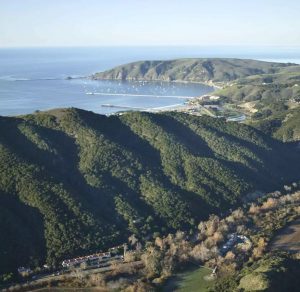 Located on over 100 wooded acres, the Sycamore Mineral Springs Resort’s most defining feature is the restorative power of the naturally heated mineral water. The resort has a variety of mineral baths including the unique Oasis Waterfall Lagoon, a scenic hillside hot tub, or a private guest room tub. All of the 72 guest rooms include individual hot mineral spring tubs on private balconies or patios.
Located on over 100 wooded acres, the Sycamore Mineral Springs Resort’s most defining feature is the restorative power of the naturally heated mineral water. The resort has a variety of mineral baths including the unique Oasis Waterfall Lagoon, a scenic hillside hot tub, or a private guest room tub. All of the 72 guest rooms include individual hot mineral spring tubs on private balconies or patios.
There are also 23 open-air naturally heated mineral spring hot tubs open to the public, that line the peaceful tree-canopied hillside. Each hot tub is surrounded by a beautiful rich wood fence with lattice detail to ensure privacy from other guests while still providing majestic views and a serene environment.
Innovative healing arts classes are taught by a selected staff of professional instructors. “Strengthen, stretch, calm, and rejuvenate your way to a better you.” The instructors are dedicated to the art of healing. Their teachings embrace the connection between the mind, body, and spirit and you will find they are genuine extensions of everything they teach. Daily classes feature Yoga, Pilates, Tai Chi, and more. All classes are open to the public and priced per session, per person. Resort guests receive unlimited complimentary classes. Private instruction 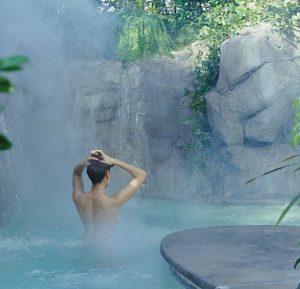 available upon request.
available upon request.
The Sycamore Mineral Springs Resort has been voted a top global destination mineral spring resort by Spa and Spa Finder magazines. The spa treatments are designed to enliven your senses while providing you with healing benefits sourced from nature. For example: “The Hot Springs Stone massage blends traditional massage techniques with heated basalt stones to penetrate tension and improve circulation with warmth and comfort to ease your stressed muscles. The White Algae Facial is ideal for sensitive or dry skin and uses calcium rich white algae, white tea, and copper peptides to calm and soothe irritated skin while evening out skin tone. The Sundaria Seaweed Body Scrub detoxifies with a full body dry brush exfoliation and  organic bio-scrub blend of seaweed, pumice, acai and guarana to polish skin and purify pores. A marine-based oil filled with sea minerals and antioxidants leaves skin hydrated and repaired. The dry brush is given as a gift so you can continue your detoxifying treatments at home.”
organic bio-scrub blend of seaweed, pumice, acai and guarana to polish skin and purify pores. A marine-based oil filled with sea minerals and antioxidants leaves skin hydrated and repaired. The dry brush is given as a gift so you can continue your detoxifying treatments at home.”
“The highly acclaimed, Gardens of Avila Restaurant is widely known for its seasonal and spontaneous garden cuisine.” The menu includes local seafood like the Morro Bay fish and chips with local rock fish fried in beer batter, French fries, house made coleslaw and lemon aioli; Local Artisan Cheese Plate with Central Coast Creamery‘s sea scape & bishops peak, fiscalini bandage white cheddar, local honey, toasted almonds, local berries and local salami (optional). There are intimate settings for indoor and outdoor dining. The restaurant features produce harvested on the resort’s one-acre organic Chef’s Garden as well as local farmers markets.
THE SAN LUIS OBISPO WINE CONTRY
 “Winemaking is deeply rooted in SLO Wine Country, dating back to the 18th century with the founding of Mission San Luis Obispo by Father Junipero Serra in 1772.” [1] Here, the padres grew grapes and made them into sacramental wines. A century later, commercial wine was produced from grapes grown at Rancho Saucelito in the upper Arroyo Grande Valley. The old Zinfandel vines planted in 1880 by Henry Ditmas were restored by the Greenough family in the 1970s, and remain a cornerstone of Saucelito Canyon Vineyard.
“Winemaking is deeply rooted in SLO Wine Country, dating back to the 18th century with the founding of Mission San Luis Obispo by Father Junipero Serra in 1772.” [1] Here, the padres grew grapes and made them into sacramental wines. A century later, commercial wine was produced from grapes grown at Rancho Saucelito in the upper Arroyo Grande Valley. The old Zinfandel vines planted in 1880 by Henry Ditmas were restored by the Greenough family in the 1970s, and remain a cornerstone of Saucelito Canyon Vineyard.
 The modern wine industry in the SLO Coast emerged in the 1970s. In 1973, the Goss family had the foresight to plant Chardonnay at Chamisal Vineyard in the Edna Valley. Concurrently, the Niven family planted Pinot Noir, Chardonnay and other varietals at Paragon Vineyard. MacGregor Vineyard was planted in 1976 and is now the home of Wolff Vineyards. The success of these early plantings of Chardonnay and Pinot Noir ignited SLO Wine Country’s reputation as a world-class region for Burgundian varietals.
The modern wine industry in the SLO Coast emerged in the 1970s. In 1973, the Goss family had the foresight to plant Chardonnay at Chamisal Vineyard in the Edna Valley. Concurrently, the Niven family planted Pinot Noir, Chardonnay and other varietals at Paragon Vineyard. MacGregor Vineyard was planted in 1976 and is now the home of Wolff Vineyards. The success of these early plantings of Chardonnay and Pinot Noir ignited SLO Wine Country’s reputation as a world-class region for Burgundian varietals.
In 1979, Lawrence Winery was established as the region’s first modern winery, and the property is today home to Center of Effort Winery. Chamisal Vineyard began making its own wine in 1980, and Edna Valley Vineyard followed in 1981 as a partnership between Paragon Vineyard and Chalone Vineyard. Claiborne & Churchill Winery, Maison Deutz (now Laetitia Vineyard & Winery), and Talley Vineyards soon added further momentum to the local winemaking scene. These early wineries paved the way and put SLO Wine Country on the map.
SLO Wine Country includes two small adjoining American Viticultural Areas—the Edna Valley and Arroyo Grande Valley—and other nearby wine growing areas. Each of these areas shares a unifying proximity to the ocean, as well as to each other.
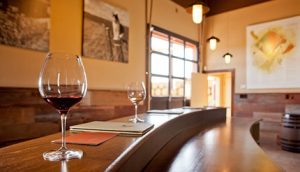 The Arroyo Grande Valley is a predominantly northeast-southwest oriented coastal valley that is recognized as one of the most temperate viticultural areas in the world. These ideal conditions result in a long and mild growing season, with bud bread typically occurring in mid-February, flowering in early May and harvest in late September. Still widely planted to vegetables on the valley floor, wine growing in the valley dates to the 1880’s when Zinfandel was planted in the warmer eastern part of the valley. The modern era began in the 1980s with plantings of Chardonnay and Pinot Noir on the hillsides of the western end of the valley, closer to the coast.
The Arroyo Grande Valley is a predominantly northeast-southwest oriented coastal valley that is recognized as one of the most temperate viticultural areas in the world. These ideal conditions result in a long and mild growing season, with bud bread typically occurring in mid-February, flowering in early May and harvest in late September. Still widely planted to vegetables on the valley floor, wine growing in the valley dates to the 1880’s when Zinfandel was planted in the warmer eastern part of the valley. The modern era began in the 1980s with plantings of Chardonnay and Pinot Noir on the hillsides of the western end of the valley, closer to the coast.
 San Luis Obispo Sycamore Mineral Springs Resort and Spa is centrally located for exploring Edna Valley, Arroyo Grande, Avila Valley, and Paso Robles wine regions. There are numerous excellent wine tours available, with pick-up at our resort. Onsite wine experiences are also available so you don’t have to leave the premises to enjoy award-winning central coast excellence.Whether you are a wine novice or happen to be a sommelier, everyone will enjoy the wine tasting opportunities throughout the Central Coast. In 2013 our area was awarded “World’s Best Wine Region” by Wine Enthusiast magazine.
San Luis Obispo Sycamore Mineral Springs Resort and Spa is centrally located for exploring Edna Valley, Arroyo Grande, Avila Valley, and Paso Robles wine regions. There are numerous excellent wine tours available, with pick-up at our resort. Onsite wine experiences are also available so you don’t have to leave the premises to enjoy award-winning central coast excellence.Whether you are a wine novice or happen to be a sommelier, everyone will enjoy the wine tasting opportunities throughout the Central Coast. In 2013 our area was awarded “World’s Best Wine Region” by Wine Enthusiast magazine.
The philosophy that exceptional wines can be approached by all tasters shines bright in over 450 wineries from Arroyo Grande to Paso Robles. Intimate tasting rooms, beautiful outdoor areas, and laid-back settings invite you to discover your ideal wines.
San Luis Obispo, with its heritage, festivals and points of interest, is a wonderful place to visit. Next time you’re looking for an unusual place to visit, treat yourself and the family to a magical time, bath in the hot springs, visit a winery and enjoy the many picturesque hikes and natural wonders of San Luis Obispo.
Brought to you by Kaz Headrest. Travel in comfort with a Kaz Headrest. Available on


